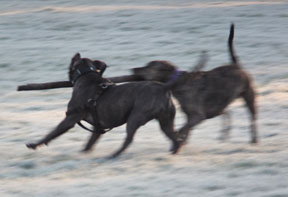Access to Land – Towns
 The desire to have access to urban parks where dogs can play freely is often seen to be in conflict with children. This seems mainly due to the fear of the zoonosis toxocariasis and to dogs being perceived as being out of control.
The desire to have access to urban parks where dogs can play freely is often seen to be in conflict with children. This seems mainly due to the fear of the zoonosis toxocariasis and to dogs being perceived as being out of control.
Toxocara canis roundworms live in dogs’ digestive system. They are also carried by foxes and cats. Eggs are deposited in soil when dogs defecate and can cause toxocariasis in humans who ingest contaminated soil. It takes 10-21 days for the eggs to become infectious and they can lie dormant for months, which it is why it is important to remove fresh faeces. Puppies can pick up worms from their mother so require worming more regularly than adult dogs. [1] It is important to use wormers under the direction of your vet. There are different wormers on the market covering different parasites and some covers fleas and worms and fleas and ticks. Your dog’s anti-parasite regime will be dependent on the environment and the season.
Always pick up after your dog and make sure that you follow a suitable worming regimen under veterinary guidance. Respect areas where dogs are not allowed and ensure that your dog is under control at all times. Train your dog not to jump up and not to beg for or steal food.
Access to Land – the Countryside and Coast
We will support all campaigns for fair access to land and oppose illegal or unreasonable restrictions on dog walkers…. Read more
However, access to the countryside has to be seen in the context of the land, not as a playground for urban dwellers, but as somewhere that provides many people with their livelihood and town and country dweller alike with food.
Farmers Weekly magazine estimates that worrying livestock costs farmers £1.2 million per annum. The Farmers Guardian sent Freedom of Information requests to all 51 police forces in the UK and asked them to provide information on dog attacks from January 1st to December 31st, 2012. It found that attacks on livestock increased from 691 in 2011 to 739 in 2012, mostly with sheep being attacked, injured or killed.
Restrictions on access to land have developed due to irresponsible people not abiding by the Countryside Code and irresponsible owners not controlling their dogs. Respect signs – they are usually there for your safety.
Some areas may not be accessible at certain times such as during lambing and calving. Extreme care should be taken when walking near livestock. 18 people were killed and 481 injured by cows between 2001 and 2009. [2]
Dog handlers have a duty of care under the law to ensure that their dog does not worry livestock. A dog does not need to make contact with animals to be considered to be worrying them and farmers are allowed to take reasonable steps to protect their stock, even if it causes harm to your dog.
Follow the Countryside Code [3] at all times. Avoid areas where there are livestock, especially if they have young at foot or are in lamb, calf or foal. Keep your dog on the lead if you are not sure if there are livestock nearby. Shut all gates that you open securely. If you do get charged by cattle DROP YOUR LEAD and protect yourself.
Remember that cliffs and water are dangerous. RNLI volunteers risk their own lives to rescue dogs and owners from rivers and coasts year after year [4]. Never go in water or cross ice to rescue your dog. Never put yourself in danger on coastal paths or beaches.
[1] http://www.nhs.uk/conditions/Toxocariasis/Pages/Introduction.aspx
[2] http://www.bbc.co.uk/news/uk-scotland-22874612
[3] https://www.gov.uk/government/publications/the-countryside-code/the-countryside-code
[4] http://rnli.org/Search/Pages/results.aspx?k=dog